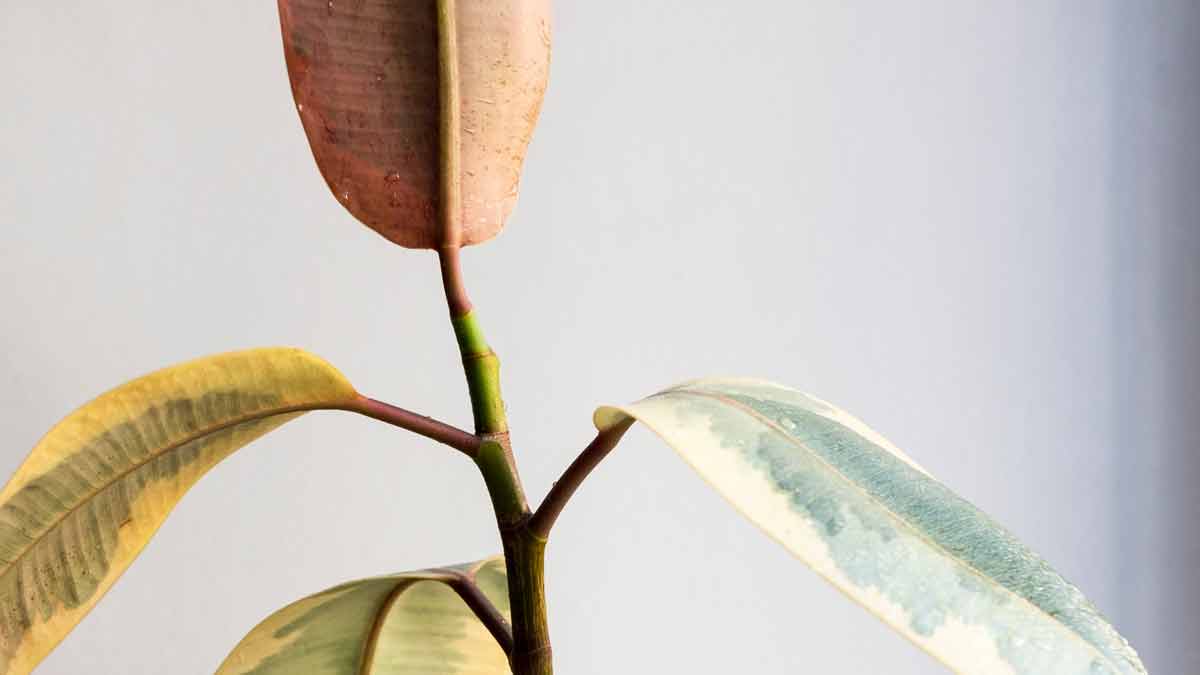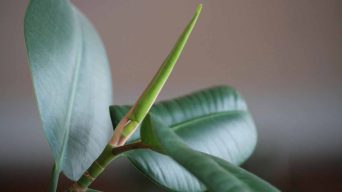Rubber plants, the Ficus elastica, are one of the most popular houseplants. They’re easy to care for, can tolerate various indoor conditions, and make a great addition to any home décor.
One issue you may encounter with your rubber plant is legginess. The plant becomes excessively tall and thin, with bare stems and few leaves.
While leggy rubber plants are not necessarily unhealthy, they don’t look very attractive.
There are a few reasons why your rubber plant may be leggy.
Here you will find everything you need to know about how to fix a leggy rubber plant.
What Causes a Rubber Plant to Become Leggy?
There are a few reasons why your rubber plant may be leggy.
The most common cause is insufficient light. Rubber plants need bright, indirect sunlight to thrive. If they don’t get enough light, they will stretch and become leggy in an attempt to reach the light source.
The lack of light will also cause the leaves to become smaller and fewer in number. This is another reason why leggy rubber plants are not very attractive.
Low light is the most common cause of legginess in rubber plants, but it’s not the only one.
High nitrogen levels in the soil can also cause legginess. This is because nitrogen encourages growth, so the plant will become taller and thinner if there is too much of it in the soil.
It is usually a result of overfertilizing the plant.
Rubber plant owners make overfertilizing a common mistake, as they want their plants to grow quickly. However, too much fertilizer can do more harm than good.
How To Tell If Your Rubber Plant Is Leggy
The first step in fixing a leggy rubber plant is to determine whether or not the plant is leggy.
There are a few signs that you can look for to tell if your rubber plant is leggy.
These include:
The Plant Is Tall and Thin
One of the most obvious signs of a leggy rubber plant is that it will be taller and thinner than a healthy plant.
The stems will be bare, with few leaves.
This is because the plant is trying to reach the light source, so it will grow taller and thinner in an attempt to get more light.
The Leaves Are Far Apart
Another sign of a leggy rubber plant is that the leaves will be far apart.
This is because the plant is trying to reach the light, so the leaves are spread out in an attempt to get more light.
The leaves will also be smaller than usual, as the plant is not getting enough light.
The Rubber Plant Is Pale Green or Yellow
If your rubber plant is leggy, it will be a pale green or yellow color.
This is because the plant is not getting enough light, so the chlorophyll in the leaves is not being produced correctly.
This will cause the leaves to be a pale green or yellow color.
The Rubber Plant Has Few Leaves
Another sign of a leggy ficus elastica plant is that it will have few leaves.
This is because the plant is not getting enough light, so it cannot produce enough leaves.
The leaves that are produced will be small and far apart.
The Plant Is Not Growing
If your rubber plant is leggy, it will not grow as quickly as a healthy plant.
This is because the plant is not getting enough light or nutrients, so it cannot grow as quickly.
The Plant Is Drooping
A leggy rubber plant will often droop as the stems are not strong enough to support the weight of the leaves.
This is because the plant is not getting enough light, so the stems are not as strong as they should be.
The Rubber Plant Is Falling Over
If your rubber plant is leggy, it may fall over.
This is because the plant is not getting enough light, so the stems are not strong enough to support the weight of the leaves.
The roots may also be weak, so the plant may fall over if it is not supported.
The Rubber Plant Looks Unhealthy
If your rubber plant is leggy, it will often look unhealthy.
This is because the plant is not getting enough light or nutrients, so it cannot produce enough chlorophyll.
The leaves will be a pale green or yellow, and the plant will often look droopy.
How To Fix a Leggy Rubber Plant
Once you have determined that your rubber plant is leggy, there are a few things that you can do to fix the problem.
These include:
Move the Plant to a Bright Location
If your rubber plant is leggy, it is probably because it is not getting enough light.
The best way to fix this problem is to move the plant to a bright location.
Ensure the plant is in a spot where it will get at least six hours of light per day.
Rubber plants need bright indirect light to grow properly.
However, if you live in an area with a lot of sun, you may need to move the plant to a spot that gets some shade during the day.
Too much direct sunlight can scorch the leaves of a rubber plant.
Prune the Plant
If your rubber plant is leggy, you can prune it to encourage new growth.
Start by trimming off any dying or dead leaves.
Then, cut the stems back to about 6 inches.
You can also remove any leaves far away from the main stem.
Make sure you use sharp, clean pruning shears to avoid damaging the plant.
Repot the Plant in Fresh Soil
If your rubber plant is leggy, it may be because it is overfertilized.
To fix this problem, you can repot the plant in fresh soil.
Make sure that you use a high-quality potting mix that is well-draining.
To improve drainage, add some perlite or vermiculite to the potting mix.
Don’t Overfertilize the Plant
If your rubber plant is leggy, it may be because it is overfertilized.
To fix this problem, you can reduce the fertilizer you use.
Fertilize the plant every two weeks during the growing season and once a month during the winter.
Use a balanced fertilizer that is formulated for indoor plants.
Follow the directions on the fertilizer label to avoid overfertilizing the plant.
How to Prune a Leggy Rubber Plant
If your rubber plant has become leggy, don’t despair!
You can encourage the leggy plant to grow fuller and healthier by pruning it back.
Here’s how to do it:
- Begin by cutting off any dead or damaged leaves. These can be removed at any time of the year.
- Next, cut back the longest stems, leaving around 6 to 8 inches (15-20 cm) of the stem.
- Make sure to cut at an angle, just above a leaf node (the point where leaves are attached to the stem).
- You can also remove any stems that are growing in the wrong direction.
- If your plant is still looking leggy, you can repeat this process every few months until it fills out.
Pruning your rubber plant is a simple way to encourage it to grow fuller and healthier.
Following the steps above, you can keep your plant looking its best.
How To Prevent a Leggy Rubber Plant
There are a few things that you can do to prevent your rubber plant from becoming leggy.
These include:
Give the Plant Plenty of Light
Rubber plants need bright indirect light to grow properly.
If your plant is not getting enough light, it will become leggy.
Ensure the plant is in a spot where it will get at least six hours of bright light daily.
However, if you live in an area with a lot of sun, you may need to move the plant to a spot that gets some shade during the day.
Place your plant near an east- or west-facing window. This will give it the bright indirect light that it needs.
Turn the Plant Regularly
Another way to prevent your rubber tree plant from becoming leggy is to turn it regularly.
As the plant grows, it will start to lean towards the light.
If you turn the plant every week or so, it will grow evenly and not become lopsided.
Prune the Plant Regularly
Pruning your rubber plant will also help to prevent it from becoming leggy.
When you prune the plant, cut just above a leaf node.
This will encourage the plant to branch out and become fuller.
Ficus elastica plants can be pruned at any time of year.
Don’t Overfertilize the Plant
If you fertilize your rubber plant too much, it will become leggy.
To prevent this, only fertilize the plant every two weeks during the growing season and once a month during the winter.
Don’t use a high-nitrogen fertilizer, which can cause the plant to grow too quickly.
Instead, use a balanced fertilizer that is formulated for indoor plants.
Follow the directions on the fertilizer label to avoid overfertilizing the plant.
Repot the Plant Every Few Years
If you repot your rubber plant every few years, it will stay healthy and not become leggy.
When you repot the plant, choose a pot that is only one size larger than the current pot.
This will give the plant enough room to grow without becoming rootbound.
Be sure to use a well-draining potting mix designed for indoor plants.
Add some shredded bark or perlite to the potting mix to improve drainage.
Following these tips can prevent your rubber plant from becoming leggy and keep it looking its best.
Final Thoughts
Rubber plant care is easy once you get the hang of it.
These plants are very resilient and can tolerate a wide range of conditions, but they will need extra TLC if they start to look leggy.
The most important thing to remember is to prune regularly and give them plenty of bright light.
With patience and care, your rubber plant will look lush and full in no time!







